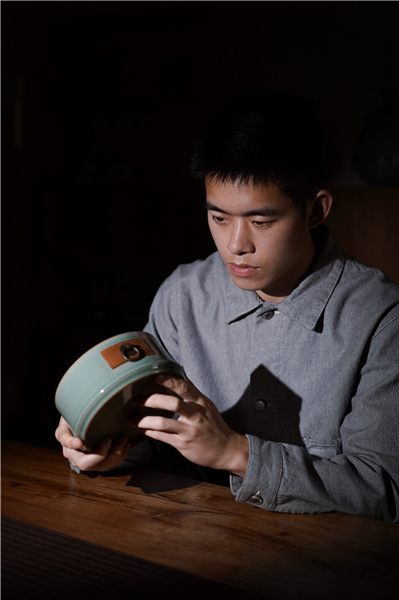
There's big room for modern design and innovation that would help popularize the ancient art among younger consumers. [Photo provided to China Daily]
Ceramic craftsman brings style to ancient skill with innovative design.
Ye Chenxi turned away from the lure of big city life seven years ago and went back to his mountainous home to carry on the family tradition.
The 29-year-old from Longquan, a small county-level city of East China's Zhejiang province, has been working on modern design for celadon, a green-glazed Chinese ceramic that first appeared during the Three Kingdoms (220-280) and reached its zenith in the middle and late periods of the Song Dynasty (960-1279).
Longquan has been a major site for celadon production.
The Longquan celadon features multiple layers of greenish or grayish blue glaze, which resemble jade.
Ye's family has been engaged in celadon craftsmanship for more than 200 years, from the reign of Emperor Jiaqing (1796-1820) of the Qing Dynasty (1644-1911).
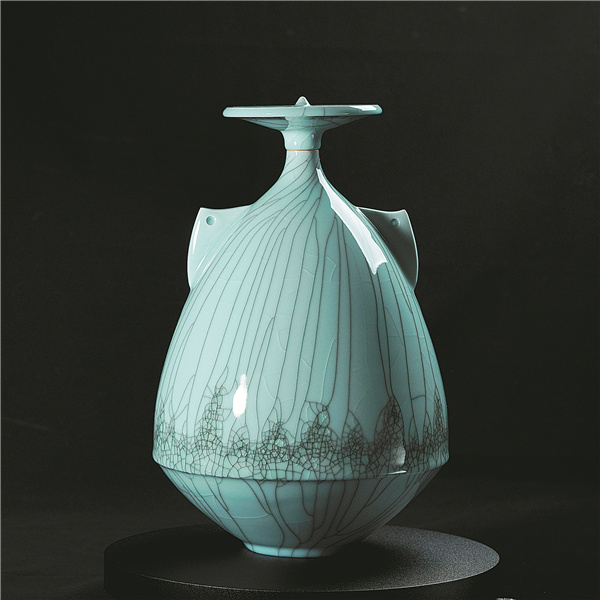
Migration, artwork by Ye Chenxi. [Photo provided to China Daily]
Ye's father Ye Xiaochun is a sixth generation inheritor.
Ye Xiaochun spent five years experimenting with a recipe, lost for a thousand years, for celadon products with a cracked ice surface. He eventually restored the stunning glaze pattern in 2001.
"It was a sense of responsibility that had me decide to carry on what my family has been doing," Ye Chenxi says.
It was no easy choice. By the time he finished product and interior design studies in college in Hangzhou, capital of Zhejiang province in 2015, Ye says he had grown used to city life.
"I had developed a circle of friends, and enjoyed visiting various exhibitions on weekends," he says.
But celadon's pull on him got stronger as childhood memories flashed back and his design expertise gave him a new perspective.

Celadon with a cracked ice surface. [Photo provided to China Daily]
Celadon has been widely used in Longquan, where Ye spent many a childhood summer vacation at his grandparents' place.
"The stretchy green mountain and farmlands leapt into my eyes when I opened the window in the morning," he says.
"It was just close to beauty of the glaze color of celadon."
Across the river, he often saw wisps of smoke rise from the chimney of the ceramic plant where his father worked.
Ye played with his friends at the plant sometimes, and the scene where adults were working on the clay was also etched on his mind.
"The furnace was huge and could take in hundreds of bottles and plates," he recalls.
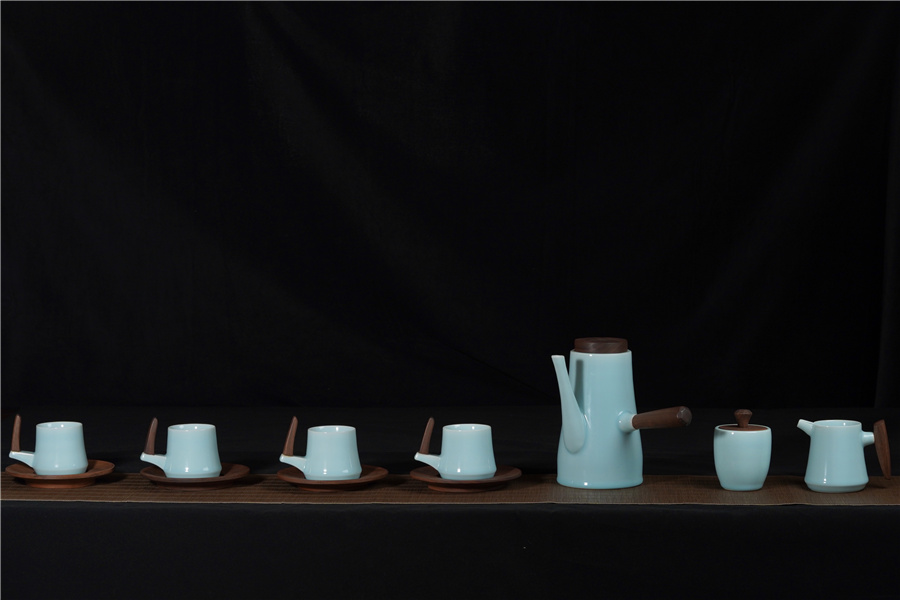
There's big room for modern design and innovation that would help popularize the ancient art among younger consumers. [Photo provided to China Daily]
"The grown-ups would cheer and laugh once the kiln furnace was opened and arrays of celadon products jumped into the eye."
At dinner time, Ye's grandmother would serve steaming food on the celadon wares.
"Now I think of it, the green color really set off the food, stimulating one's appetite," Ye says.
After he looked at celadon through the eye of a design student, Ye discerned the potential of celadon innovation.
In his opinion, the overall celadon industry has been strictly sticking to tradition and there's big room for modern design and innovation that would help popularize the ancient art among younger consumers.

Ye Chenxi's father Ye Xiaochun is a sixth generation inheritor of the Longquan celadon. [Photo provided to China Daily]
Ye applied to pursue a master's degree in ceramic design at Jingdezhen Ceramic Institute in the neighboring Jiangxi province in 2016.
"I needed to know more about celadon to further my goal," Ye says.
Upon his arrival, he was immediately drawn to the open and inclusive ceramic art ambience permeating through Jingdezhen, widely considered as China's porcelain capital.
"A great many artists engage in their artistic creations there, and you can find various processes and approaches for ceramic making," he says.
Knowing his ultimate purpose, Ye's professor encouraged him to focus on celadon design and integrate it with modern techniques.
Whenever he met with a problem at school, he would call his father, and they would work out the kinks in the way.
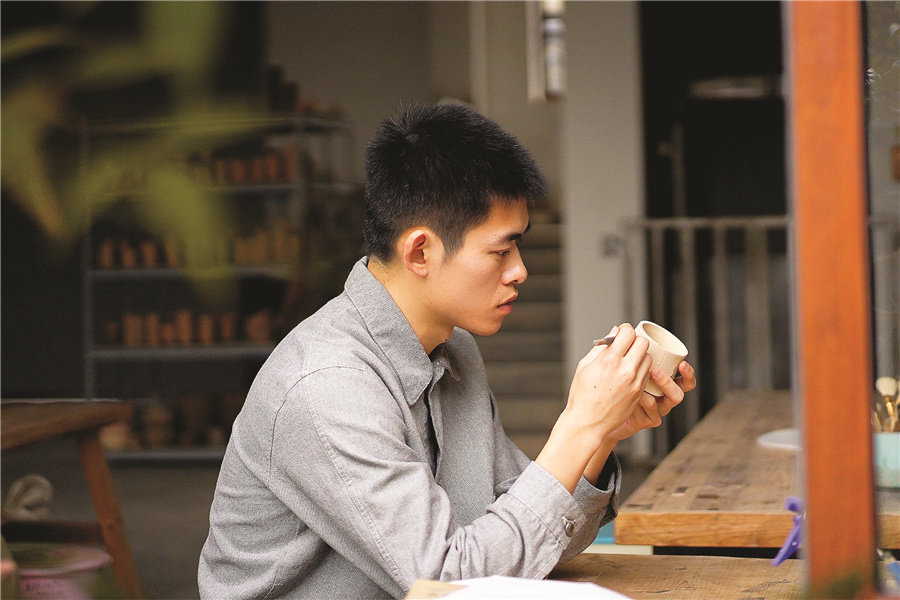
Ye Chenxi's father Ye Xiaochun is a sixth generation inheritor of the Longquan celadon. [Photo provided to China Daily]
During his study in Jingdezhen, Ye developed many innovative celadon works, such as the Forest of Ceramic Language, which tried to express the interweaving of humanity and nature.
Ye put together wood and ceramics and developed them into an English afternoon tea set.
The modest and flexible black walnut and elegant and rigid blue and white ceramic were used as the main materials of the tea set and coexisted in harmony through modern technique.
He didn't go into tedious carving but only highlighted the simple and clear exterior lines, with an aim of sending the breath of nature to the fingertips of the tea set users.
His work won the silver prize at the 11th China Ceramic Art Exhibition in 2018.
Ye went back to Longquan right after he graduated from the Jingdezhen university in 2019.
In most cases, his day runs like clockworks.
He deals with the whole shooting match, including clay molding and firing and glaze concoction.
"It's at least eight-hour work a day that is filled with both beautiful and painful moments," Ye says.
He is alone at work most of the time, and steps are complex and each one calls for intense concentration.
For example, when looking for clay, he needs to find the right type in the vast mountains, and then pulverize, wash and filter them.
All the trouble is worth it once the celadon turns out beautifully after the baptism of fire, about 1,300 C, he says.
However, things are in flux until the last moment.
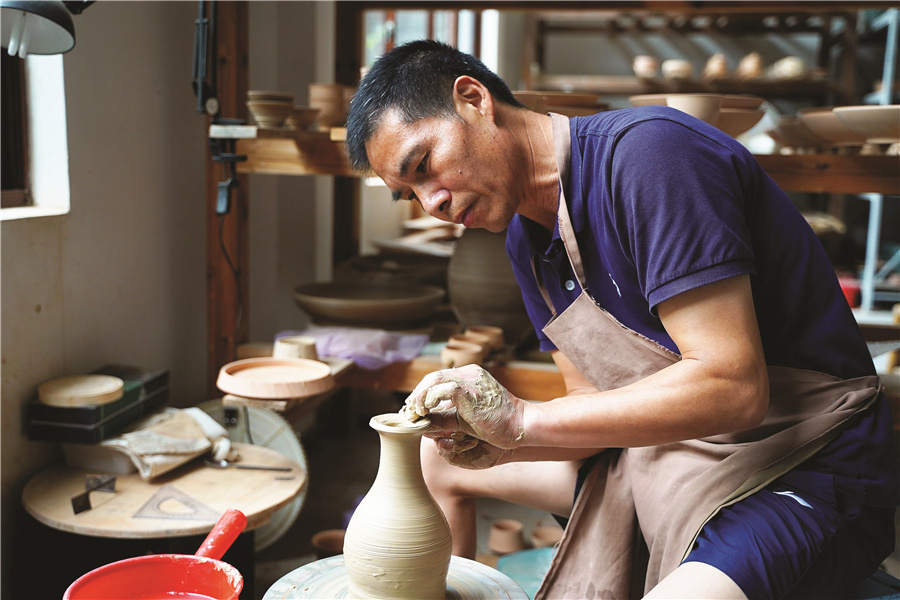
Ye Chenxi's father Ye Xiaochun is a sixth generation inheritor of the Longquan celadon. [Photo provided to China Daily]
"You might make a great model, but it could collapse during the fire process. If the glaze was too thick or too thin, or impurities from the air got in, they would all leave undesirable marks on the final products," Ye Chenxi says.
He would review the whole process after every failure.
Ye and his family are living in an artist zone in Longquan. He and his father would often sit by the pool and discuss celadon creation and life. They also went to the depths of mountain to search for the right materials from time to time.
"Kilning is the hardest work, but it is very good test for celadon makers," says Ye Xiaochun, who started working at a local ceramic plant at 17 and spent four years in the kilning division.
Although the cracked ice glaze has already been successfully restored, the finished product rates have only stayed at around 30 percent.
Ye Xiaochun says he used to take Ye Chenxi to play in the mountain.
"My purpose was to take him to see the porcelain clay, so that he could have a certain understanding of it since childhood, because pottery itself also depends on our nature," Ye Xiaochun says.
This early influence has got into Ye Chenxi, because he has chosen his life trajectory entirely on his own.
Last year, he used leather and wood on celadon and made a set of items for study rooms, such as pen holders and ink boxes and showed them at a Shanghai exhibition.
"Young people were interested in my things," says Ye Chenxi.
It has encouraged him to make further inroads in celadon product design.
"The goal is to make celadon closer to the public and cheaper," he says.

